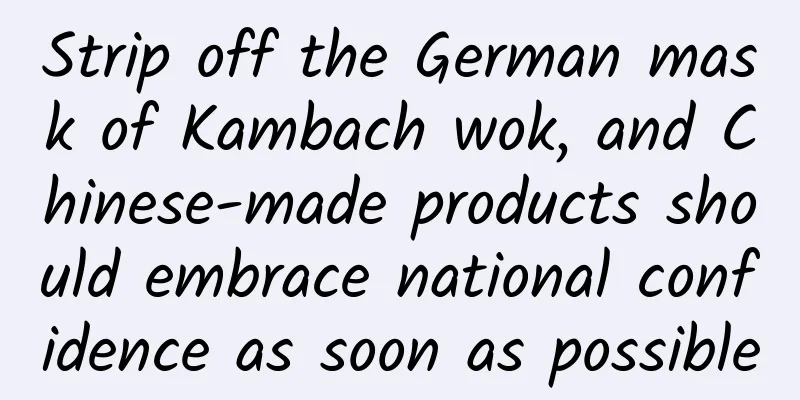Strip off the German mask of Kambach wok, and Chinese-made products should embrace national confidence as soon as possible

|
From Playboy and Ports clothing in the past to Dettol hand sanitizer, Da Vinci furniture, and today's Cambach woks, it is not uncommon to see Chinese-made products claiming to have European and American ancestry. Obviously, there is cognitive inertia formed by consumers over a long period of time, but the main responsibility still lies with the merchants. They use various puzzles created by information asymmetry to lure consumers into the "foreign brand" trap they have carefully woven. To be honest, these fake foreign brands are not unusable. They are definitely usable, but the quality is definitely not as good as consumers imagine. After all, the prices of these brands are often very affordable. However, the biggest problem is that their unrealistic publicity routines have also damaged our national self-confidence to a certain extent - deliberately creating a consumer illusion that European and American products are superior to Chinese products. Hot "German" frying pan Top live streamer Wei Ya has made Kambach popular. This wok, which claims to be a "German brand" but is actually produced in Cixi, Zhejiang, has used the trick of high-dimensionality to defeat low-dimensionality as soon as it was launched. Under the banner of "Germany", it directly targets the price of Supor's products, inducing consumers to have a secret pleasure of "spending RMB to buy German products". Although Europeans and Americans are not used to cooking and rarely use woks, this does not prevent fake foreign brands from entering the Chinese wok market. This is all due to the rapid growth of the relevant market in China over the past decade. According to research data from Toubao Research, the scale of China's wok market is expected to exceed 15.7 billion yuan by 2023, with a compound annual growth rate of 11.9%. Because the market has a super high growth rate and huge capacity, Cambach, a Zhejiang company founded in 2012, rushed in. Of course, the live broadcast room of Viya, who has been working hard to promote the brand, is actually just a small channel of Kambach. Data from Alibaba shows that since 2017, Combach has been the top German cookware brand on Tmall for three consecutive years. On Singles' Day in 2019, Combach's total sales reached 28.67 million yuan, with nearly 100,000 products sold, ranking first in sales in multiple categories such as woks and frying pans on Tmall. However, as Cambach has become a leader in the Chinese market, its product problems have gradually been exposed. The Cambach 316 stainless steel wok recommended by Wei Ya alone has more than 500 negative reviews. Consumers have said that the Cambach 316 stainless steel wok not only has quality problems such as "sticking to the pan", but also has design problems such as "the edge of the pan is too hot to hold with one hand". Along with the product problems, the German background of KAMBERG also surfaced. Everything is not that simple. KAMBERG's German "Painted Skin" According to an article on Kamberg's official website, the reason why it was able to successfully "break the circle" in the Chinese market is mainly due to two factors: first, it took the mid-range product route of overseas high-end products; second, it had revolutionary innovations in technology. From the brand point of view, KAMBERG claims that it was founded in Germany in 1911, with its office address in Garmisch-Partenkirchen, its founder is Kurt Felix, and it officially entered the Chinese market in 2012. However, according to media reports, there is no such company as KAMBERG in Garmisch-Partenkirchen, and there is no more introduction of Kurt Felix on Google. It was not until 2013 that KAMBERG's trademark was registered in Germany. From the trademark information of KAMBAH, its trademark owner is "Zhejiang KBH Kitchenware Co., Ltd.". Using this as a keyword, the search result points to "Zhejiang Bach Kitchenware Co., Ltd.". Interestingly, Zhejiang Bach Kitchenware Co., Ltd. was established in 2012. It is extremely ironic that as early as 2017, the Wuyi County Market Supervision Bureau imposed administrative penalties on Zhejiang Bach Kitchenware Co., Ltd. for "misleading false advertising violations such as using German kitchenware brands in the promotion of Cambach pots." This is tantamount to declaring in disguise that the Cambach brand is just a publicity point, not a real German brand. Secondly, from a technical point of view, the patented honeycomb etching technology that Kambach has been promoting has indeed passed the certification of the State Intellectual Property Office, with the patent number ZL 2013 1 0089292.6. However, the ownership of the patent also points to Zhejiang Bach Kitchenware Co., Ltd., and the inventor of the patent is Yan Weixing, one of the shareholders of Zhejiang Bach Kitchenware Co., Ltd. From the perspective of the industry, Zhejiang Bach Kitchenware Co., Ltd.'s brand promotion and operation of Kambach is also highly utilitarian. For example, in October 2019, Zhejiang Bach Kitchenware Co., Ltd. filed a 10 billion patent lawsuit against Supor. Considering that one month later on Double Eleven, Kambach touted its sales growth of 336% year-on-year and total sales of over 27.24 million yuan, and filed a lawsuit against Supor in October, it seemed that Kambach had a "drunkard's intention was not to drink" meaning to touch porcelain. Based on this, we have reason to draw such a picture. When Zhou Heping saw that the non-stick pan market was about to explode in 2012, he first founded Zhejiang Bach Kitchenware Co., Ltd., and then went to Germany to register a "Combach" brand. This allowed Zhejiang Bach Kitchenware Co., Ltd. to reap the domestic market dividends under the German high-end brand tone of "Combach". When will fake foreign brands disappear? Although Zhejiang Bach Kitchenware Co., Ltd.'s business model has major problems, it has been common in the Chinese market over the past two decades. The most notorious of these, Da Vinci Furniture, has even become a special term for this phenomenon. When it was founded in 1994, Da Vinci Furniture advertised its products as "imported furniture" from Italy and "international top brand" furniture. However, in 2011, CCTV's "Weekly Quality Report" clearly told everyone that Da Vinci furniture was all produced by Dongguan under a brand name, and the product logos were seriously irregular. In addition, Da Vinci furniture had repeatedly exposed quality problems, making Da Vinci furniture a pariah overnight. The reason why there are so many "Da Vinci phenomena" in our Chinese consumer life is mainly because unscrupulous merchants wantonly trample on national self-confidence and deliberately create the false idea that foreign goods are superior to Chinese goods. However, it is gratifying that with China's manufacturing industry leading the global market and the successful transformation of China's "smart manufacturing", the "Da Vinci phenomenon" has gradually begun to fade at the level of core industrial chains such as chips. Take the mobile phone industry as an example. Huawei, OV and other leading brands have long occupied the world market, and there are almost no "Da Vinci-style" brands in the industry. However, for products with high frequency of daily use, this phenomenon often shows extremely tenacious vitality because of the different consumer groups it targets. Throughout history, whether it is Da Vinci furniture, Nobel tiles or Marco Polo tiles, although they can seize the initiative with fake foreign brands, due to "unworthy of the position", there is a sense of disparity between the product and the brand, which easily arouses consumer disgust. The reason why Cambach wok has been repeatedly criticized is that it has fallen into this product vicious circle. A person cannot stand without credibility, and this is true for both products and countries. To be confident, we should start by facing our own product brands and acknowledging the origin of our products. In fact, we are very proud of it. Cambachs, wake up, times have changed! As a winner of Toutiao's Qingyun Plan and Baijiahao's Bai+ Plan, the 2019 Baidu Digital Author of the Year, the Baijiahao's Most Popular Author in the Technology Field, the 2019 Sogou Technology and Culture Author, and the 2021 Baijiahao Quarterly Influential Creator, he has won many awards, including the 2013 Sohu Best Industry Media Person, the 2015 China New Media Entrepreneurship Competition Beijing Third Place, the 2015 Guangmang Experience Award, the 2015 China New Media Entrepreneurship Competition Finals Third Place, and the 2018 Baidu Dynamic Annual Powerful Celebrity. |
>>: Amadeus: 2022 Q2 Travel Market Insights Report
Recommend
Self-cultivation of a UI button
Editor's note: What qualities does a qualifie...
Lanzhou online medical consultation mini program function, how much does it cost to develop an online medical consultation mini program?
With the continuous development of informatization...
Tourism promotion, how does Lanzhou Tourism Company conduct online promotion?
As people's living standards continue to impr...
How to monetize knowledge in the era of Internet celebrities: Hujiang CCtalk has pioneered a path to lead educational reform
Live-streaming influencers are nothing new nowada...
After Walmart fully acquires No.1 Store, can it still expand offline?
Yesterday was the general meeting of all employee...
Breaking the dependence on imports! CCTV praised the good life of a Zhejiang University academician who is good at coal
Recently, China Central Radio and Television'...
Low-key Ganzi, Sichuan, contains such a unique color aesthetics
Ganzi, Sichuan A very humble name It encompasses ...
The first person to eat abalone was a Chinese, and the first person to measure the heartbeat of abalone was also a Chinese!
According to the visible written records, the fir...
Explain the correct use of the AARRR model in WeChat mini-programs
Building a mini program product from 0-1 is not j...
How to plan an excellent event? Follow these 5 steps
Whether you are doing user operations, new media ...
If you don't eat meat regularly, your brain will be "very damaged"
Author: Lao Ke opens his mind Audit: Superb Many ...
Who is the strongest marine creature? A review of the strongest marine creatures in history. The overlord of the ocean needs to have both offensive and defensive capabilities.
The ocean is the cradle of life. Life is born in ...
Urgent reminder! Many people have been detained recently, be careful before Qingming Festival...
Recently, Qionghai, Hainan A grass fire After rec...
Hisense TV's crazy expansion of content pool may lead to crisis
On March 18, Hisense signed contracts with 11 vid...
Source code | Uber's welcome screen
Source code introduction: Uber welcome page. Uber...









![[Breaking News] AppStore shopping categories are now online, check out the TOP1500 first!](/upload/images/67cc4094d347c.webp)